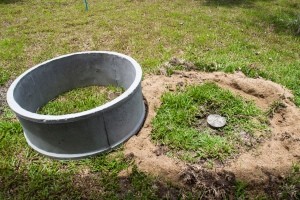 What can I plant over our new cesspool (where we had lots of rhodies, azaleas, and andromedas before)? It's a large triangular space in the front of our house. I want something year round and fast growers, if that's possible. We live in Suffolk County, New York.
What can I plant over our new cesspool (where we had lots of rhodies, azaleas, and andromedas before)? It's a large triangular space in the front of our house. I want something year round and fast growers, if that's possible. We live in Suffolk County, New York.
By Lucy
Cesspools are pretty deep. Any plant that stays under 4 feet tall at full maturity should work fine. Mine did, but I lived in Lancaster, CA. High desert area. We even had a small tree near it. It was already there when we moved in, so I don't know what kind it was. Not sure if the root would eventually interfere with the function of drainage, but the guy who pumped ours said anything directly over should be around 4 to 5 feet at full maturity. So I went on the safe side and stayed at 4 feet max.
Here are the questions asked by community members. Read on to see the answers provided by the ThriftyFun community.
Hardiness Zone: 9a
SusannL from Florida
A: SusannL,
You have several options for landscaping your septic system. You can landscape with lawn, ornamental grasses, ground covers and ornamental plants. Drought tolerant plants are best, and edible crops that require frequent irrigation are not recommended because the need for constant watering (and digging) can overload your system. The most important thing to remember is to choose low maintenance, low growing plants with shallow, non-invasive roots.
You don't ask about ideas for plants to use over the drainfield, but planting the same types of low maintenance, shallow-root plants in this area can actually keep your system running optimally. Plants can actually help provide the drainfield area with oxygen exchange and contribute to evaporation. This will help keep your septic system running optimally. Don't plant edibles here either, as they will be directly exposed to effluent leeching into the ground from your drainage pipes. Do not use landscape fabric, plastic, bark or mulch around your septic system and do your best to avoid compacting the soil.
Here is small list of plants often recommended for landscaping around septic systems. Contact your county extension agency for more ideas specific to your zone.
Grasses: fescue, ornamental grasses, lawn.
Ground covers: bugleweed, carpet heathers, cotoneaster, ground ivy, periwinkle(sun); bunchberry, ferns, mosses, sweet woodruff, wild ginger, wintergreen (shade).
Ornamentals: petunias, marigold, zinnia, impatiens, geranium.
Ellen
Generally- if I remember this right from class- you can plant many different types of grasses (yes, there are types!). Call your local nursery, ask if they have any ornamental grasses which prefer a wet environment. Call around if you have to, and get the latin names of the plants, then put together brief descriptions.
not sure if a filter bed is the same as a septic bed but hubby has been planting his veggie garden on ours for last 2 yrs and its done well. Good luck on finding something to plant
Remember whatever you do,that septic tanks have to be cleaned out once in a while. The only way to do that is to uncover the septic tank and open it up. So be careful not to plant anything that is precious to you. Or anything that cannot be torn out or transplanted when the need arises.
Unless there is a problem, tanks don't need to be cleaned out often. But proper maintenance requires a clean out,
Hope this helps. I use a combination of items on mine. A rusted folding chair, rusty lantern, piece of rope and old cowboy boots for decoration. We live in Arizona so a western theme works for us.
pats
We have tulips over our unused septic tank. We also have day lilies and easter lilies. Hope that helps.
The previous owners of our home planted three English laurel bushes on top of the septic field. They have grown quite big and I'm concerned that the root system will damage the septic system. I started scraping the surface ground away and the roots appear to run close to the surface of the ground. Do you know how deep the roots grow?
Levor